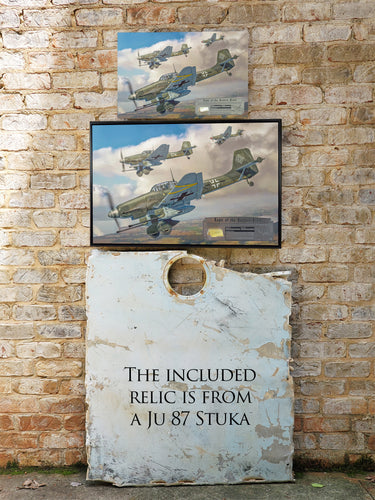This Fine Art Print by Artist Craig Tinder illustrates the initiation of a tank strafing run by the Luftwaffe's most decorated servicemen - Hans-Ulrich Rudel in one of his many Junkers Ju 87 Stuka dive bombers.
Details About the RELIC:
This relic comes from a large 34" x 36" section of the port wing of a JU-87 B-1 Stuka, W.Nr. 5611, recovered near Yukhnov, Russia. The panel, still coated with original RLM 76 (light blue) paint, displays access hatches, oil streaks, and remnants of Russian soil in its stringers. This aircraft, part of II/StG1, was severely damaged by anti-aircraft fire on April 18, 1942, during the German advance on the Eastern Front. Despite their injuries, both the pilot, Lt. Hans Buchholz, and his radio operator, Uffz. Hans Bayerlein, survived the crash, making an emergency landing in an area that had been liberated by Soviet forces just a month earlier.
The aircraft suffered an 80% loss during the crash, with significant damage caused by the intense flak that hit it during its mission. The crash site, located 70 km west-northwest of Kaluga, was a hotspot for combat activity during this period, as the Soviets had launched counter-offensives to reclaim lost ground. This intact panel is a rare remnant of the aircraft, providing insight into both the machine's design and the ferocity of the battles it participated in.
Lt. Hans Buchholz and Uffz. Hans Bayerlein were fortunate to survive the crash, but the damage inflicted on the aircraft during its final mission underscores the peril faced by Stuka pilots in these high-risk operations. The JU-87 Stuka, known for its infamous dive-bombing tactics and terrifying siren, played a crucial role in early German victories, but by 1942, it was increasingly vulnerable to Allied anti-aircraft fire and superior fighters. This artifact not only represents a tangible piece of aviation history but also serves as a testament to the endurance and bravery of the crews who flew in these dangerous missions.
 "Eagle on the Eastern Front' canvas print with relics
"Eagle on the Eastern Front' canvas print with relics
 Starboard underwing panel of JU 87B-1 Stuka
Starboard underwing panel of JU 87B-1 Stuka
The Story Behind the Print:
Hans-Ulrich Rudel was a highly decorated German Stuka dive-bomber pilot during World War II, known for his incredible feats as a combat pilot. Flying over 2,500 missions, Rudel was credited with the destruction of numerous Soviet tanks, artillery pieces, and even several ships. His precision and fearlessness in battle made him a standout, and he was the only person to receive Germany's highest military honor, the Knight's Cross with Golden Oak Leaves, Swords, and Diamonds.
Rudel was best known for his role in the Eastern Front, where he became a significant threat to Soviet forces. He was particularly effective against armored vehicles, claiming over 500 tank kills, as well as the sinking of the Soviet battleship Marat. Despite being wounded multiple times and losing a leg, Rudel continued flying, demonstrating extreme determination and resilience. His combat success made him a symbol of German military prowess in the air.
After the war, Rudel's post-war activities were controversial, as he remained unrepentant about his Nazi affiliation. Despite this, his skills as a pilot and his numerous combat achievements remain unmatched in military aviation history. Rudel’s legacy is a complex one, marked by his extraordinary wartime record and his controversial views and actions after the conflict.
 Junkers Ju-87 "Stuka" at the Royal Air Force Museum
Junkers Ju-87 "Stuka" at the Royal Air Force Museum
Learn more about Why Did the Stuka Scream? The Acoustic Terror of World War II. Click Here
To purchase or see similar items, visit here.
Commissioned by Museums, Treasured by Collectors





Share:
Heroes and Foes, the story behind "Commander's Oversight"
Chasing the Sound Barrier, the story behind "Untouchable Pursuit"